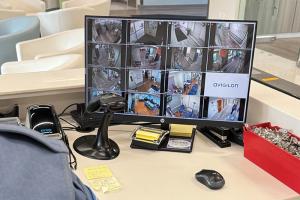Software simplifies video surveillance

Robert Leahy, MGH’s senior manager of systems and technology, reviews surveillance video.
Image courtesy of Massachusetts General Hospital
The 1,200-bed Massachusetts General Hospital (MGH) sees 49,000 admissions and 100,000 emergency room visits annually. The teaching hospital and research center employs 27,000 people and is also co-founder of Partners HealthCare Systems Inc., one of the largest nongovernment employers in Massachusetts.
With its massive operation, the MGH police, security and outside services department can have nearly 1,000 investigations to process each year, as it serves not only the flagship 17-acre urban campus comprising 29 contiguous and 14 separate buildings (including underground and free-standing garage facilities), but also dozens of satellite facilities around the Boston area. It is also tasked with providing select security services to many other Partners HealthCare hospitals and facilities.
“The number of investigations we were doing was taking huge amounts of time in terms of reviewing video, and that was really a waste of time,” says Bonnie Michelman, MGH executive director of police, security and outside services, and consultant for Partners HealthCare.
In its responsibility to create a safe environment, MGH’s security team is often confronted by myriad concerns. For instance, the clinical team’s desire for increased efficiency through lowering length of stay means patients move through the hospital quickly, making it harder to keep eyes on everyone. Also, its 24-hour emergency room — often serving anxious patients who sometimes have behavioral health needs — can present unique challenges. In addition, patient elopement and patient wandering — whether intentional or unintentional — pose liability threats that can be very damaging to a hospital.
“We can’t cover all of these facilities with security staff,” Michelman says. “We need to augment heavily with very good, state-of-the-art technology that allows us to combine our intelligence, labor, policies and procedures in order to create a better holistic approach to enterprise risk management.”
A unified system was required to balance the video surveillance needs of a busy hospital campus with remote satellite locations while upholding the highest level of security possible, maintaining operational flow and providing customer satisfaction that includes expectations of privacy.
Michelman, together with Robert Leahy, MGH’s senior manager of systems and technology, decided on the Milestone XProtect VMS platform. Camera count was increased from 400 to 1,300 and standardized with Axis network cameras connected directly to the internet protocol network. However, the team still needed a software platform that could enable fast video review, search and analysis.
To deal with the marked increase in video data, MGH’s team chose BriefCam Syndex Pro, a powerful set of tools intended to reduce the time and effort needed to conduct video reviews, post-event video investigations and real-time video monitoring. The solution, by BriefCam, Newton, Mass., ties in with the Milestone video management solution, providing efficient workflow for investigators.
According to Michelman, BriefCam has already proven invaluable. A two-year-long ROI examination of video surveillance use at MGH has shown a progressive rise in success rates with the use of videos in incident investigations.
“I see BriefCam as a very important part of our toolbox of excellent practices for protecting what is a very complex environment of tangible and intangible assets,” Michelman says.
BriefCam Syndex Pro’s ability to present video metadata in graphic visualization format, such as bar graphs, pie charts and the like, has opened new realms of possibilities to extend the role of closed-circuit television video beyond security into organizational efficiency and more informed, data-driven decision making.
“In the past, there might have been things that would have been nice to do, but we couldn’t do it because we didn’t have resources to watch that many hours of video,” Michelman says. “Now we can manage the content and we can see trends, which, in turn, can drive redeployment of resources and facilitate a better investigative focus and success.”




